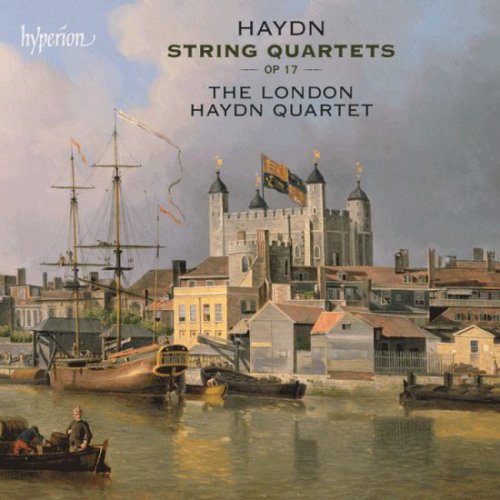
The London Haydn Quartet - Haydn: String Quartets, Op. 17 (2009)
BAND/ARTIST: The London Haydn Quartet
- Title: Haydn: String Quartets, Op. 17
- Year Of Release: 2009
- Label: Hyperion
- Genre: Classical
- Quality: APE (image + .cue, log, artwork)
- Total Time: 2:25:22
- Total Size: 747 MB
- WebSite: Album Preview
Tracklist:
Joseph Haydn (1732-1809)
CD 1
String Quartet No 4 In C Minor, Op 17
1. Moderato
2. Menuetto & Trio
3. Adagio cantabile
4. Allegro
String Quartet No 3 In E Flat Major, Op 17
5. Andante grazioso
6. Menuetto & Trio: Allegretto
7. Adagio
8. Allegro di molto
String Quartet No 2 In F Major, Op 17
9. Moderato
10. Menuetto: Allegretto
11. Adagio
12. Allegro molto
CD 2
String Quartet No 1 In E Major, Op 17
1. Moderato
2. Menuetto & Trio
3. Adagio
4. Presto
String Quartet No 5 In G Major, Op 17
5. Moderato
6. Menuetto & Trio
7. Adagio
8. Presto
String Quartet No 6 In D Major, Op 17
9. Presto
10. Menuetto & Trio
11. Largo
12. Finale: Allegro
Joseph Haydn (1732-1809)
CD 1
String Quartet No 4 In C Minor, Op 17
1. Moderato
2. Menuetto & Trio
3. Adagio cantabile
4. Allegro
String Quartet No 3 In E Flat Major, Op 17
5. Andante grazioso
6. Menuetto & Trio: Allegretto
7. Adagio
8. Allegro di molto
String Quartet No 2 In F Major, Op 17
9. Moderato
10. Menuetto: Allegretto
11. Adagio
12. Allegro molto
CD 2
String Quartet No 1 In E Major, Op 17
1. Moderato
2. Menuetto & Trio
3. Adagio
4. Presto
String Quartet No 5 In G Major, Op 17
5. Moderato
6. Menuetto & Trio
7. Adagio
8. Presto
String Quartet No 6 In D Major, Op 17
9. Presto
10. Menuetto & Trio
11. Largo
12. Finale: Allegro
Despite the success of Haydn's Op. 1 and Op. 2 quartets, issued as divertimenti a quattro, it took the composer some years to return to the quartet medium. When he finally got the chance, he issued three sets of quartets, Opp. 9, 17, and 20, within the space of three years. These were still termed divertimenti a quattro, but they were full of experiment at every level and really were the works that laid the groundwork for the persistence of the string quartet genre. The Op. 17 set recorded here by the historically oriented London Haydn Quartet was composed with a virtuoso first violinist in mind (Luigi Tomasini, the imported leader of the Esterháza court orchestra), and Haydn beautifully balances the requirement for prominent first-violin writing (melodic rather than explicitly virtuosic) with his evolving conception of the quartet as a meeting of equals. The London Haydn Quartet aptly captures the imagination and humor so often associated with this effort, but the most striking feature of the performance is the use of gut strings (with period bows) and a total rethinking of the music in light of the textures these instruments produce. The strings produce very little vibrato, a sound the quartet uses to create not an antique effect, but a hard edge. The harmonic adventures in the slow movements, which really sounded like nothing else in circulation at the time (they can't be explained by the Sturm und Drang principle), are brought into proper relief, and the high spirits of the finales, with their delightful almost fall-off-a-cliff abrupt conclusions, hit hard and satisfyingly. The very live church sound amplifies the edge of the strings, but gives the music a slightly dismembered quality. With notes in English, French, and German, this may become a standard recording of these repertory works. ~ James Manheim
Related Release:
Classical | FLAC / APE | CD-Rip
As a ISRA.CLOUD's PREMIUM member you will have the following benefits:
- Unlimited high speed downloads
- Download directly without waiting time
- Unlimited parallel downloads
- Support for download accelerators
- No advertising
- Resume broken downloads


